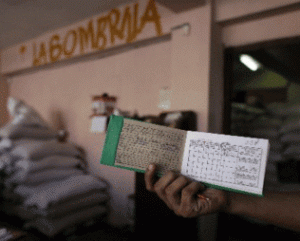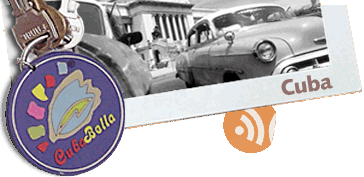Going, Going, gone…Libreta set for extinction, now what? Raised salaries? Direct payments to each Cuban or, nothing?
Comments such as this abound in Havana today – One day after the shocking news – “Cuban´s who earn 14 USD per month received the monthly rationed food, touted by the government to be valued at over 200 USD of food supplies, as a supplement to low salaries. We wonder who in government will wish to re-affirm that amount today and explain to Cuban´s what they will receive in exchange for this evident 200 USD per capita loss? Will salaries tomorrow be increased to 214 USD per month, thus covering the shortfall? Will the Libreta rations simply vanish and people still earn 14 USD per month?”
As we reported 2 months ago, Cuba, in an abrupt about face, is set to abandon the food rationing program that has been the cornerstone of its Socialist revolution since 1962, when the United States imposed an economic embargo against the island nation.
In a rare signed editorial, Lazaro Barreda, the editor of Granma, the Communist Party’s official newspaper, announced the end of the ration booklet, or Libreta, that has guaranteed an egalitarian distribution of food to the Cuban people.
“The ration booklet was a necessity at one time, but it has become an impediment to the collective decisions the nation must take,” Lazaro Barreda wrote, preparing the Cuban people for Raul Castro’s most radical departure from the Socialist ideals championed by his brother, Fidel.
The ration booklets constituted the fundamental social contract between the Communist government and the people: No matter what happened, the state would provide food for everyone.
As Cuba encountered economic setbacks, the gravest of which occurred in the 1990s when, after the collapse of the Soviet Union, Cuba entered into a prolonged recession – a “lost” decade – the Cuban population became cynical of the program.
Throughout Latin America, where poverty and hunger remain challenges for governments of all ideological persuasions, Cuba’s government has been viewed as admirable for providing a minimum number of calories to each of its citizens.
Cuba’s Ration Booklet:
Every Cuban is entitled to the following food allowance each month:
3.5 kilos of rice (7.15 pounds)
2.5 kilos of sugar (5.5 pounds)
Half a kilo of beans (1.1 pounds)
230 grams of cooking oil (8.10 ounces)
10 eggs
460 grams of spaghetti pasta (16.22 ounces)
230 grams of soy bean past (8.10 ounces)
115 grams of coffee (4 ounces)
1 loaf of bread (125 grams) (daily) (4.4 ounces)
In addition, adults are entitled to 460 of poultry (16.22 ounces) if available, and children under the age of 7 are entitled to 1 liter (34 ounces) of milk a day, distributed at school.
“It’s not much, but for almost half a century this basic basket of subsistence – all these products costs less than a euro [ or $1.45 USD] each – was a symbol of the revolution’s egalitarianism,” Mauricio Vicent wrote in El Pais, Spain’s leading newspaper.
In the daily life of Cubans, however, the “Libretas” have become a running joke, and one that has re-introduced class differences in this supposed classless society. Cubans with access to dollars (from relatives abroad, through contact with foreign tourists in Cuba, or through illicit activities) have, for more than a decade, had access to all manner of foodstuffs from the dollar-stores. Cubans with no such luck have had to fend for themselves.
Since coming to power on Feb. 28, 2008, Raul Castro has had to balance the Cuba he inherited from his brother Fidel with the reality of an economy ravaged by the aftermath of three destructive hurricanes followed by a global financial meltdown.
“In the face of the current crisis, the ration booklet has become too much of a farce for the government of Raul Castro to keep up,” Vicent wrote in El Pais, concluding that the Cuban government could no longer distribute food among its 11 million people in any reasonable manner.
Under Raul Castro, the Cuban government has been purging the “Fidelistas” and replacing them with “Raulistas.” The most stunning example was the dismissal of Foreign Chancellor Felipe Perez Roque and Cuban Vice President Carlos Lage. With most of Fidel’s protégés removed from power, Raul is now beginning to dismantle what he views as the most inefficient relics of Cuba’s Socialist principles.
Miami Cubans remain wary of any “reform” that does not include the opening of the political system and the reintroduction of capitalist reforms. In fact, the demise of the ration booklets was long rumored over the summer; a roundtable discussion was posted on YouTube that addressed the structural limits of the Socialist economic model that has hampered Raul Castro’s efforts to reform the Cuban economy.
Cuba is now confronting a critical cash flow precipitated by the consequences of devastating hurricanes that swept across the island in 2008, the global financial crisis and the consequences of a lingering dispute with the European Union, which, under the auspices of Spain, provided emergency food assistance to Cubans on humanitarian grounds.
Before the hurricanes, Cuba imported a little more than half the food it needed from aboard. Today, more than 80 percent of what Cubans eat comes from abroad – and with foreign reserves dwindling, the Cuban government is out of cash and out of credit. It is this reality, more than ideology, that is forcing Raul Castro to take urgent measures, which will strike hardest the oldest and youngest Cubans who depend on the state distribution of foodstuffs for sustenance.
For Cubans, the majority of whom are under 47 and have lived their entire lives with the “Libretas,” the abrupt ending of the food ration booklets is seen as a refining – and revolutionary – moment, as if Americans were to wake up one morning to read that Social Security and food stamps have been abolished.
And the harsh reality that confronts most of humanity will dawn on Cubans first thing in the morning: Where will I get enough calories to get me through the day?




